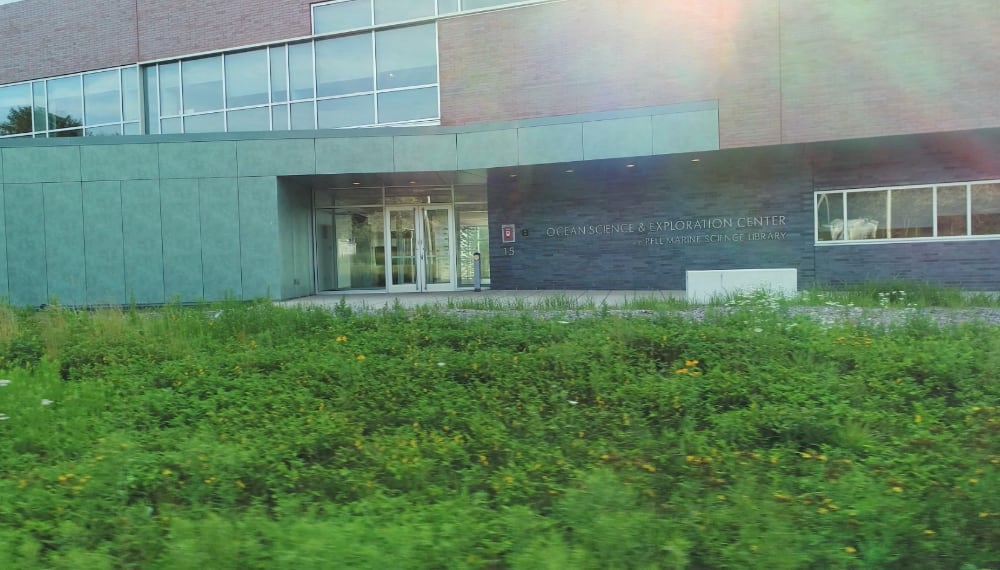NARRAGANSETT, R.I. – June 1, 2009 – In a ceremony at its Narragansett Bay Campus today, the University of Rhode Island opened the $15 million Ocean Science and Exploration Center and the Pell Marine Science Library, sparkling state-of-the-art facilities that will enable the University to remain one of the nation’s most prestigious centers of oceanographic research, exploration and education.
The project was funded by $14 million in state bonds approved by Rhode Island voters in the 2004 election and $1.5 million in federal monies secured by the state’s Congressional delegation.
“With the Inner Space Center, new labs, administrative offices and an expansion of the Pell Library, this is a sound investment in both the future of URI’s Graduate School of Oceanography and in our economy,” said Governor Donald L. Carcieri. “Next year, Rhode Island will be the home port for the Okeanos Explorer, NOAA’s newest research vessel, cementing the state’s position as a national leader in undersea exploration and research.”
“This exciting building integrates key resources of the Graduate School of Oceanography to strengthen its position as a global leader in the study of the world’s oceans,” said URI President Robert L. Carothers. “It will provide a focus for new marine science activities and become a showcase for oceanographic research and discovery.”
The centerpiece of the 41,000 square-foot facility is the Inner Space Center, which will use a satellite system and Internet2 to make it possible for URI scientists and students to participate in ocean-going research expeditions without leaving campus. The Center will enable scientists ashore to “step aboard” research ships around the world as they use advanced undersea vehicles developed by the Office of Naval Research and the National Oceanic and Atmospheric Administration to explore uncharted regions of the world. Those ships include URI’s research vessel Endeavor, the National Oceanic and Atmospheric Administration’s Okeanos Explorer, and the Ocean Exploration Trust’s Nautilus.
“This new building is the culmination of a dream I first envisioned 28 years ago to use ‘telepresence’ technology to not only make it possible for scientists all around the world to participate in live undersea exploration, but also to use the excitement of exploration to motivate the next generation of explorers to prepare them for the continuation of this adventure,” said Robert Ballard, URI professor of oceanography, director of the Institute for Archaeological Oceanography, and president of the Institute for Exploration at Mystic Aquarium.
The Inner Space Center will also be linked with other research institutions around the country, making it possible for researchers to interact in real-time with ships at sea, as well as to classrooms in Rhode Island and elsewhere, providing schoolchildren with unprecedented access to science as it happens through the Immersion Learning program.
A $1 million state grant provided the Inner Space Center with technology to support live streaming video and educational content to schools throughout Rhode Island. In addition, an in-kind contribution from National Geographic helped to equip the Inner Space Center’s television production studio and other facilities to broadcast educational programming around the world. Ballard is an explorer-in-residence with the National Geographic Society.
“With live connections from seafloor to scientists ashore, telepresence adds a whole new dimension to ocean expeditions. And with discoveries at sea viewed live in classrooms from Narragansett to Nagasaki, in news rooms, and in living rooms, telepresence promises to help raise global ocean literacy,” said Richard W. Spinrad, NOAA’s assistant administrator for oceanic and atmospheric research.
The Ocean Science and Exploration Center also houses office and laboratory space, a central computing facility, administrative offices, and a new campus gathering place. Offices for NOAA personnel, the Institute for Exploration and the Ocean Exploration Trust are also located in the building.
The top floor of the Center houses the expanded Pell Marine Science Library, one of the nation’s most important collections of oceanographic information, including the National Sea Grant Library, the Narragansett Bay Collection and Bibliography, and the administrative record of the North Cape oil spill. Established in 1968, the library’s previous site was at capacity and in need of renovation to protect its collections. The new library provides additional space for materials as well as an electronic classroom, a map room and a wireless computer network.
“This new facility will become the heart of the Graduate School of Oceanography, a place that will nurture and strengthen interactions between faculty and students,” said David Farmer, dean of the Graduate School of Oceanography. “We have created a building that evokes both a physical and intellectual center for the campus while accommodating the growing information resources necessary to sustain our research and educational programs in the 21st century.”
The architects of the center are Burt, Hill of Boston, while Providence-based Gilbane Building Co. served as general contractor. The building is expected to earn LEED certification (Leadership in Energy and Environmental Design) from the U.S. Green Building Council for its sustainable design and construction.
URI’s Graduate School of Oceanography is one of the country’s largest and most prestigious centers of marine science education and research. Founded in 1961, it serves a community of scientists who are researching aspects of the biology, physics, chemistry, geology, geophysics and archaeology of the ocean. These include seeking solutions to practical problems such as harmful algal blooms, global warming and climate change, air and water pollution, oil spills, overfishing, and coastal erosion. It is home to the Coastal Institute, the Coastal Resources Center, Rhode Island Sea Grant, the Institute for Archaeological Oceanography, and numerous outreach programs like the Metcalf Institute for Marine and Environmental Reporting.
URI Department of Communications & Marketing photo by Joe Giblin

